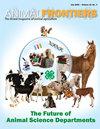Dietary impacts on rumen microbiota in beef and dairy production
IF 3.2
2区 农林科学
Q1 AGRICULTURE, DAIRY & ANIMAL SCIENCE
引用次数: 52
Abstract
The reticulo-rumen is the largest compartment of the ruminant digestive tract, and it harbors a complex anaerobic microbial community capable of producing a wide array of enzymes, some of which are important for the breakdown of plant lignocellulosic and non-structural carbohydrate (starch, sugars) material through the process of fermentation (Russell and Rychlik, 2001). Important outcomes of microbial fermentation are the production of volatile fatty acids (or short-chain fatty acids) that serve as fuels for the animal’s tissues and the synthesis of microbial protein that provides amino acids for the animal to produce high-quality protein for human consumption, i.e., meat and milk. Studies over the last few decades have conclusively demonstrated that the ruminal microbial ecosystem (both of the neonate and mature ruminant) can be altered by nutritional management (McCann et al., 2014b). Therefore, nutrition represents an important tool for manipulating the microbial ecosystem to optimize rumen function while producing high-quality meat and milk for meeting the demands of a growing human population. The recent development of omic technologies, e.g., sequencing of the 16S and 18S ribosomal RNA gene, metagenomics, and metatranscriptomics, along with bioinformatics tools, have not only enhanced the understanding of the rumen ecology, but also our ability to predict the functional capacity of the microbiota (McCann et al., 2014b). From a production standpoint, it is believed that further gains in knowledge that in the medium-to-long term could lead to practical applications will arise from the integration of taxonomic and functional data with “classical” parameters of rumen digestion, metabolism, and performance (Morgavi et al., 2013). Our aim in this review is to provide recent examples demonstrating how nutrition can alter the structure, composition, and diversity of the rumen microbiota in beef and dairy production. In addition, we attempt to highlight points where there are knowledge gaps for further research.饲料对牛肉和乳制品生产中瘤胃微生物群的影响
网状瘤胃是反刍动物消化道中最大的隔间,它容纳着一个复杂的厌氧微生物群落,能够产生多种酶,其中一些酶对于通过发酵过程分解植物木质素、纤维素和非结构碳水化合物(淀粉、糖)物质很重要(Russell and Rychlik, 2001)。微生物发酵的重要结果是产生挥发性脂肪酸(或短链脂肪酸),作为动物组织的燃料,并合成微生物蛋白,为动物提供氨基酸,以生产供人类食用的高质量蛋白质,即肉和奶。过去几十年的研究已经明确表明,营养管理可以改变瘤胃微生物生态系统(包括新生和成熟反刍动物)(McCann et al., 2014b)。因此,营养是操纵微生物生态系统以优化瘤胃功能的重要工具,同时生产高质量的肉和奶,以满足不断增长的人口的需求。基因组学技术的最新发展,如16S和18S核糖体RNA基因测序、宏基因组学和亚转录组学,以及生物信息学工具,不仅增强了对瘤胃生态的理解,而且提高了我们预测微生物群功能能力的能力(McCann et al., 2014b)。从生产的角度来看,人们相信,将分类和功能数据与瘤胃消化、代谢和性能的“经典”参数相结合,将进一步获得知识,从而在中长期内实现实际应用(Morgavi et al., 2013)。我们在这篇综述中的目的是提供最近的例子来证明营养如何改变牛肉和乳制品生产中瘤胃微生物群的结构、组成和多样性。此外,我们试图强调存在知识空白的地方,以便进一步研究。
本文章由计算机程序翻译,如有差异,请以英文原文为准。
求助全文
约1分钟内获得全文
求助全文
来源期刊

Animal Frontiers
Veterinary-Food Animals
CiteScore
6.50
自引率
5.60%
发文量
74
期刊介绍:
Animal Frontiers is the official journal of the following globally active professional animal science societies:
ASAS, the American Society of Animal Science
CSAS, the Canadian Society of Animal Science
EAAP, the European Federation of Animal Science
AMSA, the American Meat Science Association
These organizations are dedicated to the advancement and dissemination of science-based knowledge concerning animal agriculture. Animal Frontiers provides a novel forum for innovative and timely perspectives that have relevance to understanding the complex dynamics at work through animal agriculture. Animal Frontiers publishes discussion and position papers that present several international perspectives on the status of high-impact, global issues in animal agriculture. Every issue will explore a theme of broad and current interest within animal science and animal agriculture.
 求助内容:
求助内容: 应助结果提醒方式:
应助结果提醒方式:


